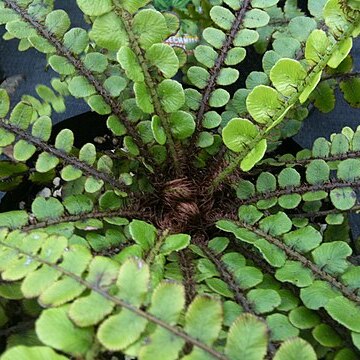Rhizome slender, short creeping, usually erect, forming a caudex 0.8-3 cm up to 30 cm in height, densely clothed with blackened bases of old stipes and with conspicuous acuminate 10 by 1.2 mm scales, entire, shiny, reddish brown, sometimes with paler borders. Fronds in the living state forming a distinct spreading crown at the apex of rhizome, with the fertile fronds more erect and surrounded by a drooping or prostrate rosette of numerous olive green sterile fronds, 10-75 by 1.5-7 cm (fertile fronds 1-3 cm wide). Stipes very short, up to 10 cm (usually less than 5 cm), stramineous to dark brown, densely scaly, the longest scales at the base and like those of the rhizome, acuminate, entire, brown to reddish brown. Lamina linear-oblong-narrowly elliptic, pinnate, 12-60 pairs of pinnae. Rhachis and costae stramineous to dark reddish brown, densely scaly, scales small, narrowly elliptic acuminate, sometimes falcate, entire, reddish brown, often black at their bases, interspersed with much smaller short uniseriate multicellular whitish hairs, scales extending to veins. Sterile pinnae rounded to oblong, obtuse, 0.8-4 by 0.4-1.2 cm, subpetiolate at base of lamina becoming increasingly adnate towards apex, finely cartilaginous, often membranous, mid to dark green in plants growing in shade and semi-shade, entire to crenate or dentate undulate, veins once or twice furcate, often at an acute angle to the costa and terminating in a small submarginal linear to clavate gland, usually visible on both surfaces, basal pinnae shorter and rounder. Fertile pinnae numerous, erect and usually at an acute angle to the rhachis, narrow linear, short 1-2(-3) by 0.15-0.3 cm, sessile or subpetiolate, sori covering undersurface. Spores 56.1 by 42.6 µm (from 7 herbarium specimens (Malesian material)), perine rugulose to scabrous, exine smooth to granulose.
More
Rhizome creeping or a short erect trunk. Fronds dimorphic, (fertile fronds more erect), 10-75 cm long, 1.5-7 cm wide (1-3 cm for fertile fronds). Stipe usually less than 5 cm long, stramineous, reddish or dark brown; scales acuminate, entire, brown to reddish brown. Lamina oblong-lanceolate, pinnate, with 12-50 or more pairs of pinnae; rachis and costae stramineous to reddish brown, with small brown scales and short whitish hairs; sterile pinnae rounded to oblong, obtuse, 8-37 mm long, 4-12 mm wide, shortly stalked at base of lamina, becoming increasingly adnate towards apex; margins usually crenate; basal pinnae shorter and rounder; fertile pinnae 7-22 mm long, 1.5-3.5 mm wide. Spores 50 × 39 µm; perine scaberulous; exine smooth to granulose.
Rhizome stout, erect, clad in brown subulate-attenuate paleae c. 1 cm. long; stipites numerous, tufted, paleate at base. Stipes 5-20 cm. long, slender to stout, dark brown, procumbent to ascending, ± paleate, bearing up to 50 pairs of pinnae. Sterile lamina 25-40-(75) × 2-4 cm., linear to narrow-linear, spreading, dull green, submembr. Pinnae up to 2 × 1 cm., oblong to obovate-oblong, slightly narrowed to sessile base or very shortly stalked, subopp. to alt., minutely crenulate-dentate to sinuate. Fertile lamina erect, up to 30 cm. long, linear; pinnae ascending to erect, linear-oblong, up to 2 cm. long. Sori covering whole of undersurface, indusium becoming erose.

